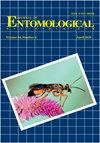香茅精油和柠檬醛对黄颡鱼蛾(鳞翅目:蚜科)幼虫的先天免疫反应
IF 0.7
4区 农林科学
Q4 ENTOMOLOGY
引用次数: 0
摘要
摘要昆虫的先天免疫反应依赖于细胞反应。在大多数鳞翅目物种中,挑战免疫系统会导致血细胞数量增加,并促进入侵物体的包裹和黑化,如寄生蜂卵或人造物体(如尼龙植入物)。我们研究了碳颗粒(Sumi ink)对香梨(鳞翅目:梨科)末龄幼虫免疫反应的影响。墨水注射以剂量依赖的方式增加了总血细胞计数,40%和80%的浓度在引起血细胞反应方面最有效。在墨水注射后4和6小时,血细胞数量显著增加。柠檬草精油(0.18、0.36和0.72µg/幼虫)和柠檬醛(0.12、0.24和0.48µg/幼虫。尼龙幼虫植入物的黑化最早在植入物插入后15分钟开始,并在1小时内达到最大观察水平。在移除植入物前1小时,用墨水攻击的幼虫的黑化程度也更高,这表明免疫反应已经初始化。柠檬醛注射液可抑制未激发和油墨激发幼虫的植入物黑化。在前一种情况下,有效抑制所需的柠檬醛浓度(0.3µg/幼虫)低于油墨攻击幼虫(1.2和2.4µg/幼虫。本文章由计算机程序翻译,如有差异,请以英文原文为准。
Innate Immune Response of Galleria mellonella (Lepidoptera: Pyralidae) Larvae to Lemongrass Essential Oil and Citral
Abstract The innate immune response in insects relies on cellular responses. In most lepidopteran species, challenging the immune system causes an increase in hemocyte numbers and promotes encapsulation and melanization of invading objects, such as parasitoid eggs or artificial objects (e.g., nylon implants). We studied the effects of carbon particles (Sumi ink) on the immune response of Galleria mellonella L. (Lepidoptera: Pyralidae) last-instar larvae. Ink injections increased total hemocyte counts in a dose-dependent manner, with the 40 and 80% concentrations being most effective in eliciting hemocyte response. Hemocyte numbers increased significantly at 4 and 6 h after ink injection. Lemongrass essential oil (0.18, 0.36, and 0.72 µg/larva) and citral (0.12, 0.24, and 0.48 µg/larva) reversed the mobilization of hemocytes by the ink. Melanization of nylon larvae implants started as early as 15 min after implant insertion and reached maximum observed levels within 1 h. The degree of melanization also was higher in larvae challenged with ink 1 h prior to implant removal, which suggests initialization of the immune response. Citral injections inhibited implant melanization both in unchallenged and ink-challenged larvae. In the former case, citral concentrations needed for effective inhibition were less (0.3 µg/larva) than in ink-challenged larvae (1.2 and 2.4 µg/larva).
求助全文
通过发布文献求助,成功后即可免费获取论文全文。
去求助
来源期刊
CiteScore
1.20
自引率
11.10%
发文量
40
审稿时长
>12 weeks
期刊介绍:
The Journal of Entomological Science (ISSN 0749-8004) is a peer-reviewed, scholarly journal that is published quarterly (January, April, July, and October) under the auspices of the Georgia Entomological Society in concert with Allen Press (Lawrence, Kansas). Manuscripts deemed acceptable for publication in the Journal report original research with insects and related arthropods or literature reviews offering foundations to innovative directions in entomological research

 求助内容:
求助内容: 应助结果提醒方式:
应助结果提醒方式:


